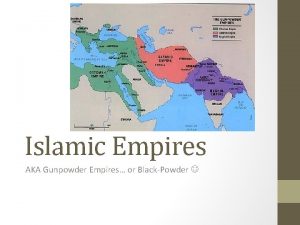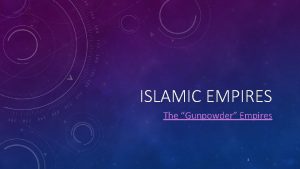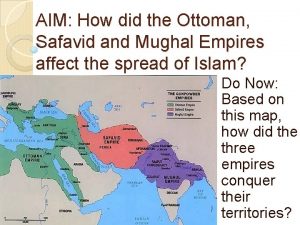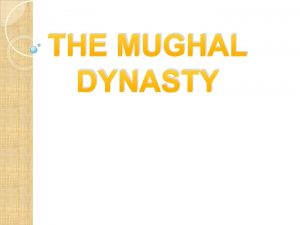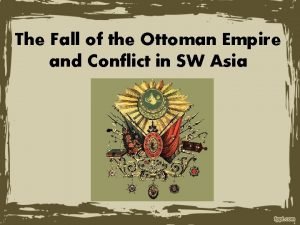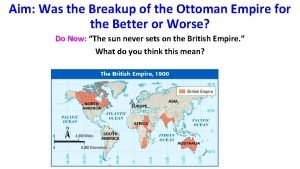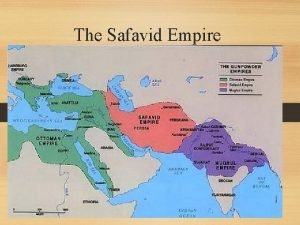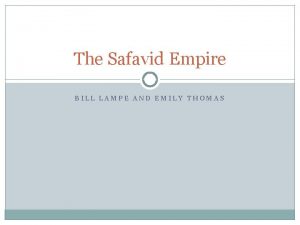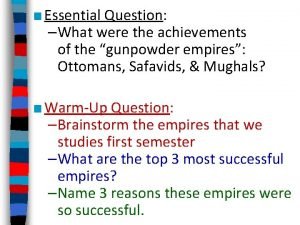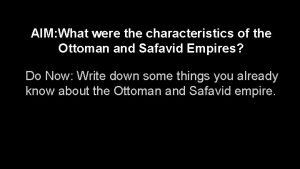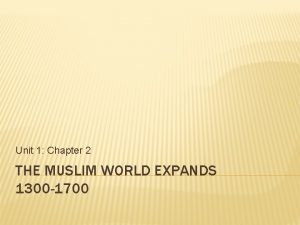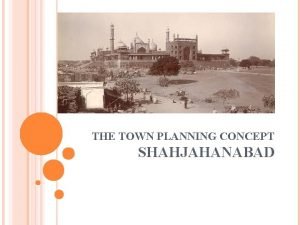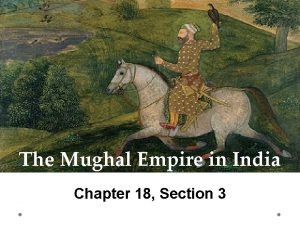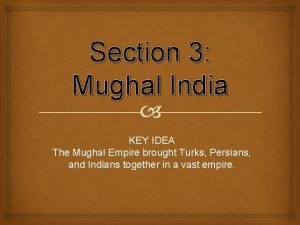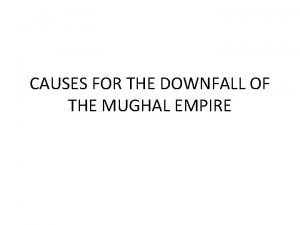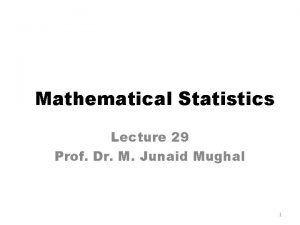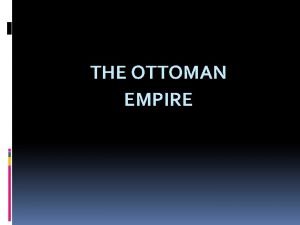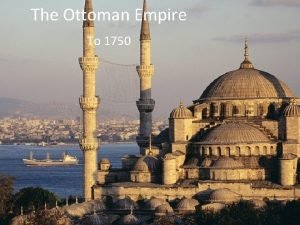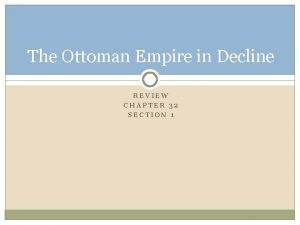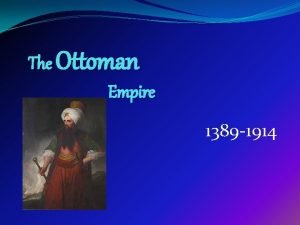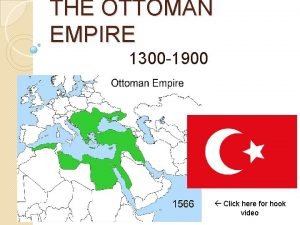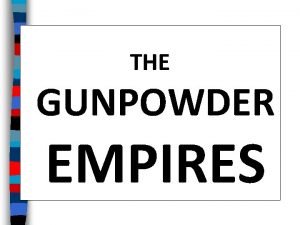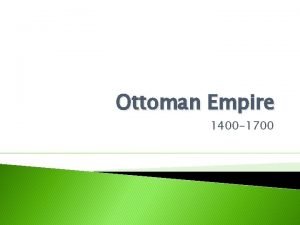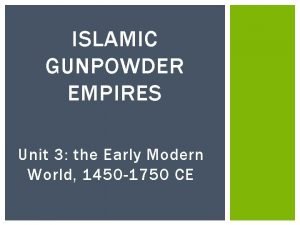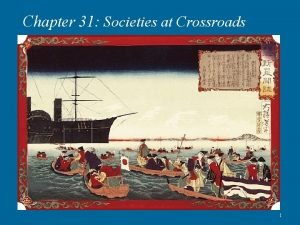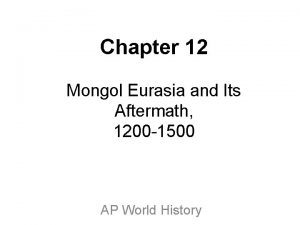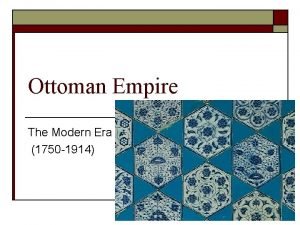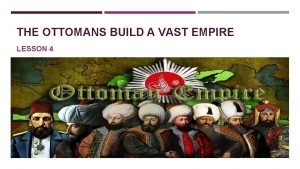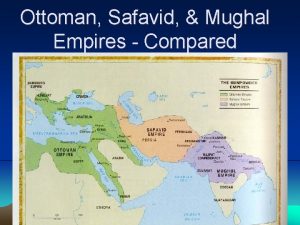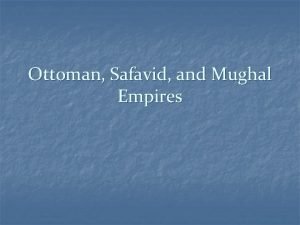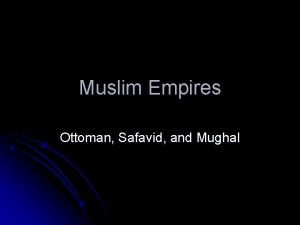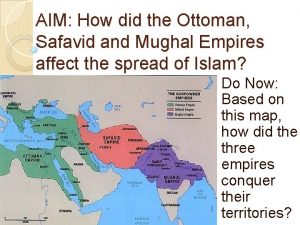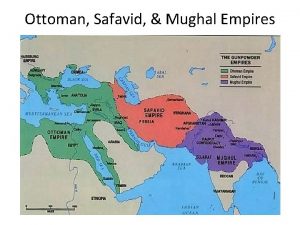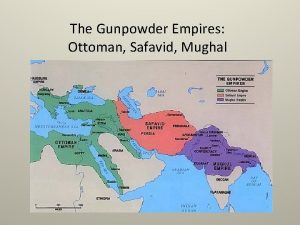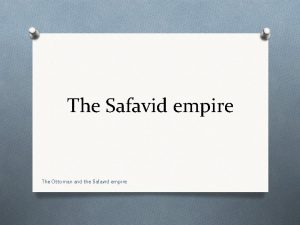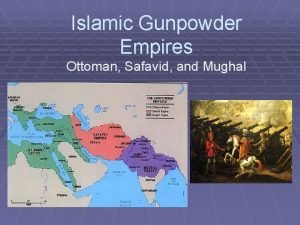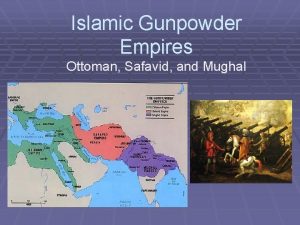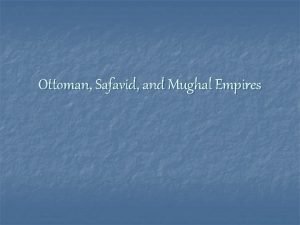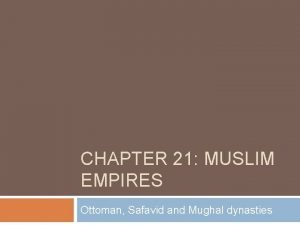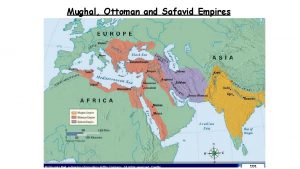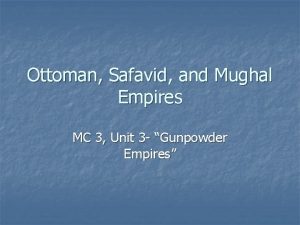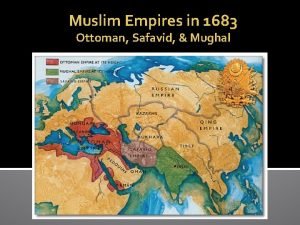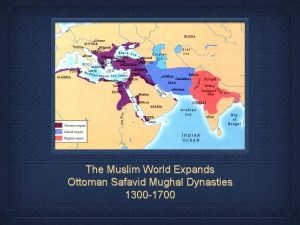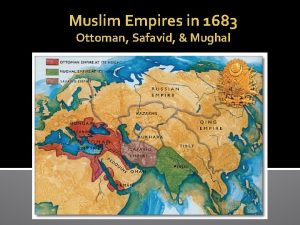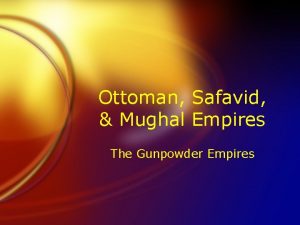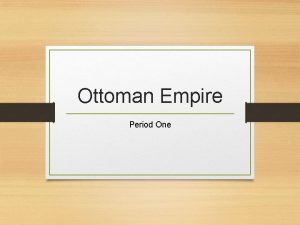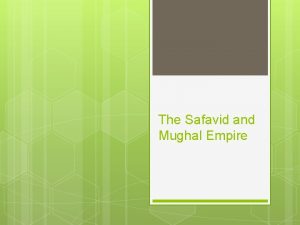AIM How did the Ottoman Safavid and Mughal











































- Slides: 43

AIM: How did the Ottoman, Safavid and Mughal Empires affect the spread of Islam? Do Now: Based on this map, how did the three empires conquer their territories?

Gunpowder!

Homework

The Ottoman, Safavid, Mughal rulers and Islam All three Islamic empires were military creations Devotion to Islam led rulers to extend faith to new lands

Steppe Traditions All three were Turkish in origin; two were Sunni

Ottoman Empire Named for Osman I Founded c. 1300 Survived to 1922, until creation of modern state of Turkey under Mustafa Kemal (Ataturk)

Sultan – Ottoman Emperor (Overlord or King) Jannissary – Christians drafted, forcibly converted to Islam and turned into an ultra elite military force by the Ottomans.

Ottoman Expansion Methods of Expansion The Ottomans controlled a “slave-like” army called the Janissaries. Made effective use of gunpowder in battles and sieges 14 th – 15 th Century Expanded into S. E. Europe ◦ Conquered Bulgaria, Serbia, Albania, Greece Mehmed the Conqueror (reigned 14511481) ◦ Captured Constantinople in 1453 ◦ Renamed city Istanbul, the Ottoman capital

Map of Ottoman Expansion

TURKISH SOCIAL STRUCTURE 1. 2. 3. 4. Men of the Pen (imams, judges, intellectuals) Men of the sword (military) Men of Negotiations (merchants) Men of Husbandry (farmers) Eventually, being in the military became a hereditary job with, and merchants and farmers had no way of joining. Women had no rights aside from tradition, class, husbands’ wishes

Reign of Suleyman Ruled 1520 - 1566 Suleyman “the Magnificent” to Europeans, Suleyman “the Lawgiver” to his subjects Famous as builder, conqueror and ruler, his reign is remembered as a “Golden Age” of the Ottoman Empire ◦ Encouraged development of arts ◦ Beautified Constantinople/Istanbul with mosques ◦ Opened the city to people of all religions

Was this a good idea? After he ruled, it became custom for a new Sultan to kill his brothers. It also became custom for Sultans to keep their sons prisoners in harems to cut them off from education Why this? do you suppose Suleymon did

Why do you suppose Suleymon did this? Kept his sons too busy to overthrow him. Killing off his brothers limited other threats to his power. Evaluate how this might affect future rulers. Led to progressively weaker rulers

In the pre-modern Middle East ◦ Identity was largely based on religion ◦ System functioned well until rise of European nationalism ◦ Most cities were divided into quarters based on religion, language

Suleimaniye Suleyman’s Mosque

Topkapi Palace and administrative center of the Ottoman Empire

Hagia Sophia Built by Justinian 532 -537

Ottoman Rivals Byzantine Empire, until 1453 Safavid Empire of Persia, after 1500 Venice and Genoa in the Aegean and Mediterranean - (Battle of Lepanto, 1571) Hungary and the Holy Roman Empire in SE Europe (sieges of Vienna 1529 and 1683) Portugal in the Red Sea, Persian Gulf and Indian Ocean

Battle of Lepanto, 1571 LETTER, H. VERONESE, Paolo

Contemporaries of Suleyman 1494– 1566 (r. 1520 - 1566) Charles V, Holy Roman Emperor, r. 1519– 1558 (Charles I of Spain, r. 1516 – 56) Henry VIII r. 1509– 47 Elizabeth I r. 1558– 1603 Francis I of France r. 1515– 47 Christopher Columbus, 1451– 1506 Martin Luther, 1483– 1546 Ignatius of Loyola, 1491– 1556 Ismail, Shah of Persia, r. 1502– 1524 Akbar, r. 1556 -1605

Ottoman Institutions Janissary Corps (yeni cheri, or “new troops” in Turkish) Conscripted Christians, converted to Islam, initially barred from marriage or other work Later, Janissary ranks were filled by devshirme system

Ottoman Decline Styles of warfare changed, artillery and firearms (Janissaries) superceded mounted archers; landed cavalry class lost power and influences Inflation from New World silver Janissaries used influence to engage in commerce and marry, eventually creating an hereditary class

Ottoman Decline Janissaries weakened as a military force Europeans increasingly dominated trade Sultans became disengaged from government, power of women in the palace grew 1718 -30 “Tulip Period” - ruinous speculation in tulip bulbs 1730 Patrona Halil rebellion Muhammad al-Wahhab (1703 -1792)

AIM: How did the Safavids and the Mughals affect history? Do Now: Quick Review: Identify each of the following as either Sunni or Shiite; Safavid, Mughal, Ottoman. HW: 536 -541: Answer 1, 3, 4, 5

Safavid Persia Founded c. 1500 by Shiite Muslim leader Ismail (r. 1501 1524) Made Shiism the state religion Westward expansion checked in 1514 at Chaldiran by Ottomans

Shah Abbas I r. 1587 - 1629 Most prominent ruler of the Safavids Came to power in 1587 Made Isfahan his capital In 1599, engaged the Englishman Sir Robert Sherley to reform army With Engish help, he drove Portuguese from Hormuz (1622) and reconquered portions of Ottoman territory

Strait of Hormuz

Safavid Empire

Impact of Persian had become the second language of Islam - behind Arabic. Often preferred to Turkish for literary or religious writing Shiism tended to isolate Persia from the rest of Islam, dominated by Ottomans Shiism teaches that leadership of the Islamic community belongs to the “Hidden Imam”- the 12 th descendant of Ali, Muhammad’s cousin and son-in -law

Muhammad al-Mahdi (The Hidden Imam) Shiism is the prophesied redeemer of Islam, and, alongside Jesus, will rid the world of wrongdoing, injustice and tyranny.

Shi’ism in Persia All temporal (secular) rulers are stand -ins for the Hidden Imam This allows the religious community of scholars, the ulama, to judge the temporal rulers, leading to a check on absolutist rule of the Shah

Isfahan

Royal Mosque

Mughal India 1526 - 1858 Founder was Babur (1483 -1530), a Turkic-Mongol descendant of Timur and Genghis Khan At the Battle of Panipat (1526), Babur defeated the last sultan of Delhi Key early ruler was Akbar (r. 15561605), who established a central administration of the Mughal state based in Delhi and Agra

Akbar sought reconciliation with Hindu majority - central problem for Moghul rulers Married a Hindu princess, who gave him an heir Rescinded the head-tax on non-Muslims Allowed two laws: sharia for Muslims and Hindu law or local custom for Hindus

Akbar’s Religious Reforms Created a translation bureau to make Hindu epics readable for the Muslim nobility of his court Created a new faith, a syncretic blend of Islam, Hinduism, Zoroastrianism, Sikh, and Christian beliefs, with himself at the center (Din-e-Elahi) Allahu Akbar (God is great)

Akbar’s successors Grandson, Shah Jahan (Selim), built the Taj Mahal as a tomb for his beloved wife, Mumtaz Mahal

Akbar’s successors Shah Jahan’s (Selim) four sons fought after his death for the throne Aurangzeb (r. 1658 -1707) prevailed and tried to reimpose sharia and the head tax on non-Muslims Aurangzeb remains a controversial figure in Indian historiography After his death, Moghul power declined

End of Moghul Rule Central administration gave way to regional autonomy - nawabs or nabobs became essentially sovereign rulers 1739 Persians sack Delhi and carry off the Peacock Throne, symbol of Mughal power Disintegration of central authority opens India to French and English intrusion Last Mughal emperor deposed in the wake of the 1857 Mutiny or Sepoy

Mughal Legacy Spread of Islam, esp. in E. Bengal Principal factors: ◦ Geography ◦ Spread of commercial farming in Ganges Delta ◦ Possibly Islam’s appeal to low-caste Hindus or Sufi evangelism Rise of Sikhism, a blend of Hindu and Muslim beliefs, in the Punjab region

Fort at Gwalior Red Fort, Agra Mughal Architecture Humayun’s tomb

Fatehpur Sikri Built by Akbar and abandoned after 15 years because of insufficient water

Golden Temple of Sikhs Amritsar, Punjab
 How did the ottoman safavid and mughal empires arise
How did the ottoman safavid and mughal empires arise Ottoman safavid and mughal empire map
Ottoman safavid and mughal empire map Ottoman safavid and mughal empire map
Ottoman safavid and mughal empire map Ottoman safavid and mughal empire map
Ottoman safavid and mughal empire map Gunpowder empires characteristics
Gunpowder empires characteristics What was the safavid mughal conflict
What was the safavid mughal conflict Mughal dynasty
Mughal dynasty How did the ottoman empire fall
How did the ottoman empire fall Breakup of the ottoman empire
Breakup of the ottoman empire Safavid empire
Safavid empire The safavid empire location
The safavid empire location Where is the safavid empire located
Where is the safavid empire located Emily lampe
Emily lampe Achievements of the safavid empire
Achievements of the safavid empire Safavid empire achievements
Safavid empire achievements Safavid empire characteristics
Safavid empire characteristics Mughal empire 1450 to 1750
Mughal empire 1450 to 1750 The muslim world expands
The muslim world expands Mughal empire location
Mughal empire location Mughal city planning
Mughal city planning Chapter 18 section 3 the mughal empire in india
Chapter 18 section 3 the mughal empire in india Chapter 18 section 3 the mughal empire in india
Chapter 18 section 3 the mughal empire in india First mughal emperor of india
First mughal emperor of india Birth of prince salim
Birth of prince salim Kathak in mughal period
Kathak in mughal period Dowmfall
Dowmfall 1761-1526
1761-1526 Srajan garg
Srajan garg The average zinc concentration recovered from a sample
The average zinc concentration recovered from a sample Kerajaan mughal merupakan kelanjutan dari kesultanan
Kerajaan mughal merupakan kelanjutan dari kesultanan The ottoman empire grew and expanded after it conquered the
The ottoman empire grew and expanded after it conquered the Ottoman empire 1750
Ottoman empire 1750 Map of ottoman empire 1800
Map of ottoman empire 1800 Was the ottoman empire tolerant of other religions
Was the ottoman empire tolerant of other religions Ottoman empire 1900
Ottoman empire 1900 Ottoman empire at its height
Ottoman empire at its height Ottoman empire 1400
Ottoman empire 1400 Ottoman architecture characteristics
Ottoman architecture characteristics Empires
Empires Map of ottoman empire 1800
Map of ottoman empire 1800 Jagadai khanate
Jagadai khanate Ottoman empire
Ottoman empire Ottoman empire 1914
Ottoman empire 1914 Who established ottoman empire
Who established ottoman empire
